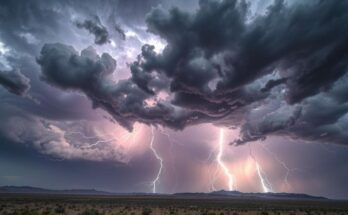Firefighters in Ofunato, Japan, are battling a rapidly spreading wildfire fueled by severe drought and strong winds, with rainfall levels drastically below average. Experts emphasize the increasing risks posed by climate change and human activity. Access difficulties and declining fire brigade personnel further complicate firefighting efforts, making effective prevention strategies and evaluation of responses essential to mitigate future wildfires.
In Ofunato, Iwate Prefecture, firefighters are grappling with a wildfire exacerbated by drought conditions and strong winds. An expert noted the escalating risk of wildfires due to climate change, highlighting the need for thorough preparedness and responsive firefighting tactics. February has brought a record low rainfall of only 2.5 millimeters, significantly below the average of 41 millimeters, leading to dangerously dry circumstances and a dry air advisory since February 18.
An office worker leading a local fire brigade described the chaos as flames surged rapidly and engulfed the area in thick smoke. The fire intensified due to wind speeds reaching an average of 7.7 meters per second, with gusts peaking at 18.1 meters per second. Research indicates that higher wind speeds can accelerate fire spread significantly, compounding the challenges firefighters face in containing the blaze, which expanded to over 600 hectares within eight hours.
The Iwate Prefectural government requested assistance from the Ground Self-Defense Forces an hour after the fire ignited, yet helicopters could not conduct water drops due to high winds. The area’s rugged and mountainous terrain complicated fire engine access, and insufficient water supplies hindered firefighting efforts. Fire brigades in the city have also decreased, with numbers dwindling by over 300 personnel in the past decade.
The most prevalent cause of forest fires remains human activity, with the Fire and Disaster Management Agency reporting that 32% of fires are caused by open-air burning. Forest fires peaked at 8,351 incidents in 1974, but approximately 1,300 fires occur annually in recent years, particularly during the driest months from February to April. The increasing vulnerability of forest land due to aging ownership and neglect further fuels fire risks.
Professor Kazunori Kuwana emphasized the need for proactive measures against wildfires, citing failures in aerial firefighting abilities as a significant factor in the fire’s rapid spread. While he noted the importance of assessing situations before requesting help, he also stressed the growing risks posed by climate change, asserting the necessity for reevaluating firefighting strategies and focusing on prevention efforts to combat wildfires effectively.
In conclusion, the ongoing wildfire situation in Ofunato exemplifies the urgent challenges posed by climate change and environmental neglect. Firefighters face heightened risks from drought and strong winds, necessitating enhanced preparation and resources. Despite past fire management strategies, the increasing frequency and intensity of wildfires underscore the need for comprehensive preventative measures and effective firefighting tactics to safeguard vulnerable regions.
Original Source: www.postguam.com




